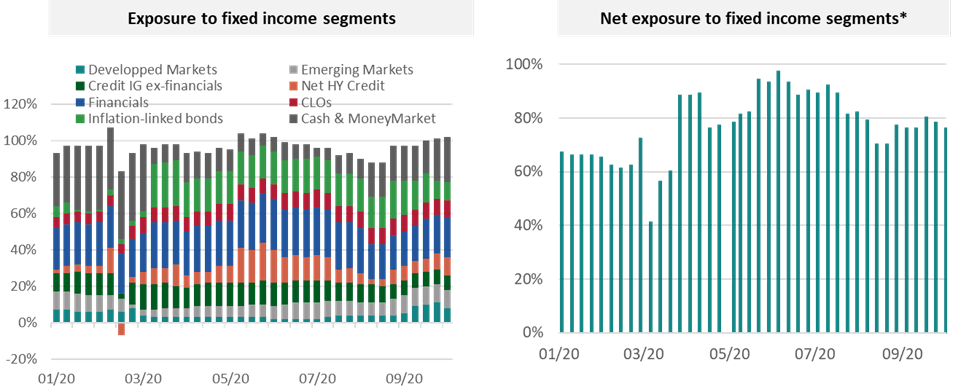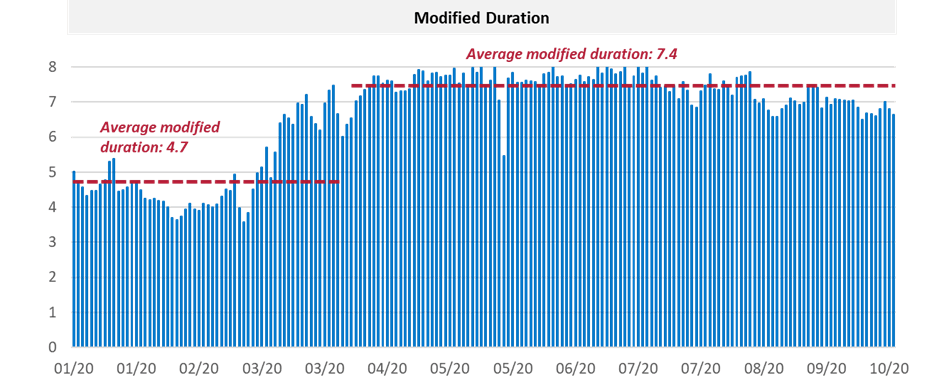Fund Focus

Carmignac P. Unconstrained Euro Fixed Income: the Fund Manager’s thought
Since March 10th, 2021, the new name of Carmignac Portfolio Unconstrained Euro Fixed Income is Carmignac Portfolio Flexible Bond.
The bond market today
After the disruption caused in the first half of the year by the Covid-19 outbreak, the third quarter seemed more placid. Yet it also saw quite a few developments with an impact on bond-market behaviour as almost all market segments booked substantial gains over the period.
-
The Covid-19 pandemic so dramatically affected global economic activity that it drove government and monetary institutions across the board to provide large-scale support.
-
In July, for example, the EU at last agreed on a Recovery Fund that set the stage for ambitious fiscal stimulus programmes. With the number of persons infected by Covid-19 worldwide rising by the end of summer, governments began preparing for a probable second wave, adopting protective policies that would impact the economy, despite the publication of better than expected economic indicators and some progress on vaccines.
US fixed income has in particular felt the impact of the recent policy shift at the Federal Reserve. To help achieve his inflation and job-growth targets, the Fed would now tolerate brief phases of economic overheating and therefore temporary increases in the inflation rate to over 2%. This announcement was enough to steepen the yield curve and strongly support Inflation-linked securities.
Another factor affecting US fixed income has been the country’s feverish political climate with no agreement reached on a new stimulus bill and no clear outlook on the upcoming presidential election. Emerging-world bond markets showed dispersion, but overall credit risk is on the mend being buoyed by US dollar depreciation and by the rebound in commodities.
Portfolio allocation
The effects of the economic downturn have been offset by stimulus policies introduced around the world, leading us to invest heavily during the second quarter in various parts of the credit space. By early July, corporate credit accounted for 64% of our fixed-income allocation. With central banks engaged in an increasingly pronounced economic support drive, we took inflation-linked bonds to 19% of our portfolio at the start of July to benefit from rising inflation expectations and falling real interest rates. We thus entered the third quarter with 91% exposure to the fixed-income market and negligible cash holdings – a sign of the many opportunities the market had to offer at that point.

*Investments – hedging via derivatives – cash & cash equivalents
Source: Carmignac, 09/10/2020
Buoyed by support from governments and central banks, high-risk credit spreads tightened fast, especially in high-yield (+3%) and subordinated financial debt (around +4%) markets. This convinced us to take profits and scale back our exposure to high-yield credit to an exposure at around 9% now.
We have nonetheless left corporate bonds at nearly 50% of our portfolio with two main convictions:
- Some issuers whose businesses took a direct battering from the Covid-19 outbreak (e.g., certain carmakers, aircraft manufacturers, etc.) with significant performance potential.
- Financial bonds, particularly the more junior issues, as they are receiving extremely generous support from central banks and are still benefiting from their efforts over the past several years to clean up their balance sheets.
This ongoing monetary policy easing should sustain low volatility in markets – a plus point for carry strategies. With that in mind, we have made a large investment in Italian government paper (9%), given that political risk is now off the country’s medium-term agenda.
During the quarter, we raised our exposure to emerging-market bonds focusing now on what are the team’s major convictions: the Mexican oil company Pemex, Romania and the Russian fuel and energy consortium. We have been especially active in the market for inflation-linked bonds and have now a substantial 10% exposure to European and US inflation-linked bonds.
Portfolio duration
During the quarter, we maintained our very high duration between 6.5 and 8. In September, we began mildly reducing our overall modified duration, keeping it below 7 years.

Source: Carmignac, 30/09/2020
Past performance is not a reliable indicator of future performance. Performances are net of fees (excluding applicable entrance fee due to the distributor). The return may increase or decrease as a result of currency fluctuations).
We maintain a high duration via hold large positions on the US and eurozone yield curves, and to a lesser extent and for diversification purposes on Australian and UK gilt yield curves, to take advantage of extremely dovish monetary policies.
The second case for maintaining high duration is that it allows us to protect a portfolio heavily invested in corporate bonds in case the economic landscape deteriorates. However, there are also yield curves on which we have opted for negative duration, for example in Hungary and the Czech Republic.
Fund performance
In the quarter, Carmignac Portfolio Unconstrained Euro Fixed Income returned +2.86% (A share class EUR Acc) versus +1.53% for its reference indicator (ICE BofA Euro Broad Index). Practically all the strategies we pursued made a positive contribution to the Fund’s performance. Corporate credit – with differentiated positioning in high-yield, investment-grade and financial bonds – lifted our return by 187 basis points.
We also booked positive results in government bonds from both the developed world (Italy) and the emerging world (mainly Romania). We also gained performance from our exposure to US and European real rates. Regarding duration management, we have mainly benefitted from our Australian bonds.
Carmignac Portfolio Flexible Bond A EUR Acc
| 2014 | 2015 | 2016 | 2017 | 2018 | 2019 | 2020 | 2021 | 2022 | 2023 |
2024 (YTD) ? Año hasta la fecha |
|
|---|---|---|---|---|---|---|---|---|---|---|---|
| Carmignac Portfolio Flexible Bond A EUR Acc | +1.98 % | -0.71 % | +0.07 % | +1.65 % | -3.40 % | +4.99 % | +9.24 % | +0.01 % | -8.02 % | +4.67 % | +2.10 % |
| Indicador de referencia | +0.10 % | -0.11 % | -0.32 % | -0.36 % | -0.37 % | -2.45 % | +3.99 % | -2.80 % | -16.93 % | +6.82 % | -0.36 % |
Desplácese a la derecha para ver la tabla completa
| 3 años | 5 años | 10 años | |
|---|---|---|---|
| Carmignac Portfolio Flexible Bond A EUR Acc | -0.40 % | +2.19 % | +1.03 % |
| Indicador de referencia | -4.33 % | -2.69 % | -1.47 % |
Desplácese a la derecha para ver la tabla completa
Fuente: Carmignac a 28/03/2024
| Costes de entrada : | 1,00% del importe que pagará usted al realizar esta inversión. Se trata de la cantidad máxima que se le cobrará. Carmignac Gestion no cobra costes de entrada. La persona que le venda el producto le comunicará cuánto se le cobrará realmente. |
| Costes de salida : | No cobramos una comisión de salida por este producto. |
| Comisiones de gestión y otros costes administrativos o de funcionamiento : | 1,20% del valor de su inversión al año. Se trata de una estimación basada en los costes reales del último año. |
| Comisiones de rendimiento : | 20,00% cuando la clase de acciones supera el indicador de referencia durante el período de rendimiento. También se pagará en caso de que la clase de acciones haya superado el indicador de referencia pero haya tenido un rendimiento negativo. El bajo rendimiento se recupera durante 5 años. La cantidad real variará según el rendimiento de su inversión. La estimación de costos agregados anterior incluye el promedio de los últimos 5 años, o desde la creación del producto si es menos de 5 años. |
| Costes de operación : | 0,38% del valor de su inversión al año. Se trata de una estimación de los costes en que incurrimos al comprar y vender las inversiones subyacentes del producto. El importe real variará en función de la cantidad que compremos y vendamos. |
Carmignac Portfolio Flexible Bond
TIPO DE INTERÉS: El riesgo de tipo de interés se traduce por una disminución del valor liquidativo en caso de variación de los tipos de interés.
CRÉDITO: El riesgo de crédito corresponde al riesgo de que el emisor no sea capaz de atender sus obligaciones.
TIPO DE CAMBIO: El riesgo de cambio está vinculado a la exposición, por medio de inversiones directas o de instrumentos financieros a plazo, a una divisa distinta de la divisa de valoración del Fondo.
RENTA VARIABLE: Las variaciones de los precios de las acciones cuya amplitud dependa de los factores económicos externos, del volumen de los títulos negociados y del nivel de capitalización de la sociedad pueden influir negativamente en la rentabilidad del Fondo.
El fondo no garantiza la preservación del capital.